Mealtime Partners, Inc.
Specializing in Assistive Dining and Drinking Equipment
September 2016 Independent Eating and Drinking Newsletter

|
September Topics:
|
||
|
Mealtime Partners Home Page Send a Comment or Suggestion |
|||
| Subscribe to Newsletters |
It’s that time again. Children are heading back to school and so it is time for us, those who work with children with disabilities, to once more make sure that we are providing the very best services to them. If you work with children who are unable to eat independently in a school setting, now is the time to plan for setting functional Individualized Education Program (IEP) goals and for developing the training pathway that will be used to reach those goals.
According to Dianne Koontz Lowman1 “No single activity is as critical to the health, education, and happiness of children with disabilities as feeding”. However, the wonderful opportunities for learning and socialization at mealtime are often overlooked because at school, just like at home, mealtimes are busy times with much to be done in a limited amount of time. This article is intended to draw attention to some of the possibilities that are available and give some direction as to how they can be pursued.
Once a child has been identified as unable to eat and/or drink independently, school staff must plan for providing food and drinks to the student. Who will take care of these needs and whether there are special medical requirements associated with eating and drinking, must be addressed. (Cultural and religious issues should also be considered.) Once the daily routine for eating and drinking is established, it is time for the therapy team to step in and look at developing strategies for improving the functional abilities of the student.
Eating and drinking require an interdisciplinary team approach that includes the family. It is not simply the domain of the occupational therapist or the speech therapist. To provide support for students who need to develop independent eating and drinking skills, a physical therapist should evaluate (with the collaboration of other team members) their seating and positioning to facilitate an optimal position for undertaking the tasks of eating and drinking. Additionally, a speech pathologist should evaluate issues relating to safe chewing and swallowing. Again, positioning is critical to safe chewing and swallowing. The student’s occupational therapist should look at the mechanics of the student getting food and liquid from a table to their mouth. The school district’s assistive technology team should also be consulted if special eating or drinking equipment needs to be considered. Even though all of these professionals must be involved in the development of goals for the student, the classroom teacher is the person who will orchestrate the plan’s implementation and who must be supported in all aspects of integrating an eating/drinking program for a student.
Classroom Aides provide much of the day-to-day assistances for students. Without the help of Aides, teachers would not be able to provide for the diverse needs of a classroom full of students. However, training for an Aide to provide services for eating and drinking should not be understated. Many classroom Aides are Mom’s who have raised children or are raising children. It is often thought that because an Aide has raised a child from a baby to an independent child who can take care of their own activities of daily living, that they are equipped with the skill set necessary to feed and provide hydration to children who are unable to undertake the tasks independently. This is a misconception.
Lowman1 states that most teachers and classroom Aides learn how to feed students “on the job”. Training to deal with complex feeding needs is received through demonstration or in-service. Stevenson and Allaire2 maintain that “a knowledge of normal feeding development, and the various factors affecting it, is essential to an understanding of feeding disorders in children with neurodevelopmental disabilities.” Understanding normal feeding development is not enough, on its own, to qualify someone to meet the specialized needs of these students. Classroom Aides must understand that when they provide food or liquid to a student, they are responsible for the safety of that student and that the risk of choking or aspiration is always present. This risk can be reduced by having Aides follow the practices for eating and drinking developed by the clinical team who support the student. The clinical team must provide the teacher and classroom aides with instructions to safely provide food and a drink to each student who needs support. This is not a situation where the same practices are appropriate for all students. Diagnosis, physical abilities, and intellectual level, impact the type of support that is necessary.
One of the great difficulties of executing any program to promote independent eating is finding the time within a busy school day. Breakfast and lunch takes less than half an hour in most schools. For many children with disabilities this is an inadequate length of time for them to practice the steps necessary to gaining mealtime independence. Instead, they are fed, and the meal is typically provided rapidly to adhere to the school’s daily schedule. Most Aides are at their busiest during meals therefore they really don’t have spare time to support teaching strategies. With this knowledge in mind, clinicians should develop strategies for teaching independent eating and drinking that can be incorporated into the rest of the school day.
Acquiring independent eating and drinking skills provides a rich teaching environment. Depending upon the functional level of the student, the student can gain competency in many areas including (but not limited to) cause and effect, counting, self-regulation, etc. Food and hunger are motivators for a student to make an effort.
For students who, for either physical and/or intellectual reasons, are unable to improve their independence for eating or drinking, assistive technology (AT) should be introduced. Mastery of these skills is often easily acquired with the use of AT. Mealtime Partners, Inc. provides a full range of AT for eating and drinking. To learn more about these products, click the following link to visit our website: Mealtime Partners Website.
| The Mealtime Partner Dining System |
|
Serving a Variety of Textures and Volumes
of Food and the Pace of Eating is User Controlled |
|
For those individuals who have chewing and swallowing difficulties, the Mealtime Partner Dining System can serve foods of a wide-range of textures. The device can serve regular table food that have been cut up, or it can serve chopped, minced, or pureed foods. The amount of food present for each bite can be controlled from a level spoonful to a rounded, or heaped spoonful. Thus small bites can be provided for those who should eat a small amount at a time. Food volume is controlled by the unique Bowl Covers that are attached to the bowls. |
 |
| Additionally, because the user controls when they take a bite of food from the spoon, they can pace how quickly or slowly they eat each bite of food. |
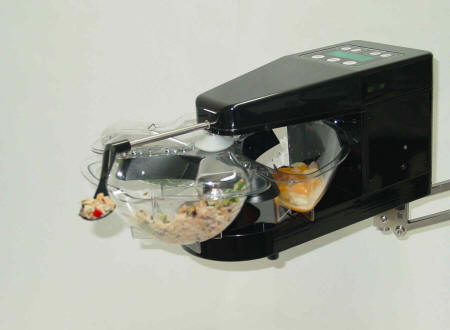 |
| The Mealtime Partner Dining Device Presenting a Bite of Food |
| Because the Mealtime Partner is such a flexible device, it can meet the dining needs of a diverse group of individuals. For complete information about the Mealtime Partner Dining System, click here. For additional information, or for assistance selecting the best eating or drinking system(s) to serve your needs, email us at info@mealtimepartners.com, or give us a call at 800-996-8607. |
There are several different methods of providing a drink: a cup can be placed at the user’s lips and tipped; a bottle can be used in the same way; or, a container with a straw can be offered. However, great caution should be used when offering someone a drink from a bottle. The inclination when drinking from a bottle, particularly a bottle with a spout top, is to lift or tip the head up and backwards. This head position poses a risk to the drinker because it exposes the airway to a possibility of the liquid “going down the wrong way”. Additionally, while the bottle is against their lips, the user is required to swallow the liquid continuously, rather than one swallow at a time. Repeated swallows without a break between each swallow, significantly increases the risk of choking. Although providing a drink from a bottle results in less spillage than a cup, it is recommended that bottles not be used, because of the increased risk of choking.
Drinking from a cup is a safe way of receiving a drink as long as the person’s head is maintained in a chin tuck. (If you are unfamiliar with promoting a chin tuck, that topic was covered in our June 2009 Newsletter article: Promoting a Chin Tuck for Safer Eating. That article applies well to drinking, also.) It is difficult to reliably provide a drink from a cup without occasional spillage. However, with practice, a partner and drink recipient usually become skilled at this task and spillage is minimal.
For a person who cannot lift a cup to their mouth, using a straw or tube that is linked to a source of liquid is the preferred method for their access to hydration. They will then to be able to drink at any time they wish. (Because a straw is a type of drinking tube, to avoid redundancy, we will use the term "straw" in the following discussion to mean any type and length of drinking tube.) Using a straw makes providing a drink much simpler and safer, and is essential for independent drinking. However, to be able to use a straw, the user must be able to form their lips around the straw to create the necessary vacuum. The user's lip closure capability requirements depend a lot upon the softness or rigidity of the straw. When selecting a straw, how much the tube will shape to the user's lips, and how much lip control the user will require to seal their lips around the straw (so that a vacuum can be developed), must be considered. (There are many varieties of straws and choosing the correct one for the individual is very important. The Mealtime Partners December 2009 Newsletter covers the topic of straws, both reusable and disposable, and provides additional insight into selecting the correct straw.)
Another important consideration when choosing a drinking system is the user’s ability to suck. If they have good strong suction, a drinking system can be mounted on the back of a wheelchair or a bed head. Alternately, a drink holder can be mounted in front of a wheelchair arm-rest and a long straw can be utilized by the user to take a drink without using their hands or having assistance. Unfortunately, many people who are unable to pick up a drink with their hands, also have a limited ability to suck and require a short straw. This reduces the mounting possibilities for a drinking system to being near the user's mouth, which is usually in front of the user, whether they are sitting in a chair at a table, are in bed, or sit in a wheelchair, with or without a laptray.
One of the simplest and inexpensive drinking systems is to use a sturdy cup or bottle (with a lid and a straw) placed on a table or laptray on a sheet of Dycem®3. However, this only works for individuals who have good coordination, no significant involuntary movements, and understand that they might tip the cup over if they are not careful. Alternately, cup holders are available that have sticky bottoms that hold them in place once they are positioned on a flat surface. They can accommodate a variety of different sizes and shapes of cups.
Another example of an independent drinking system is the Mealtime Partners Front Mounted Drinking System, shown below. It is one of the easiest drinking systems to use because it brings the drink very near the user's mouth, thus reducing the suction required for it's use. It has an advantage over the table or laptray mounting mentioned above, because it is held firmly in place and cannot be knocked over. The Front Mounted Drinking System was developed by Mealtime Partners to provide access to fluids to our customers who use wheelchairs but who have a very limited range of head and trunk movement, and, who additionally, have weak suction. The system consists of a heavy-duty flex arm that has a clamp on one end and a cup holder on the other. Several lengths of flex arms (6, 12, 18, 24 and 30-inch) are available so that this drinking system can accommodate many different individual sizes. Clamping is available for metal rails (like manual wheelchairs or hospital beds) and various wheelchairs with slide rails (sometimes referred to a T-Slot tracks) for mounting accessories. It is basically a moveable cup holder that will hold it's position once clamped to a secure base object. The pictures below show the Front Mounted Drinking System attached to both manual wheelchairs and to a wheelchair (lower-right) with a slider rail mounted under the arm. They are shown holding different types of containers. The Front Mounted Drinking System comes with a Koozie for holding smaller containers (as shown in left-side pictures).
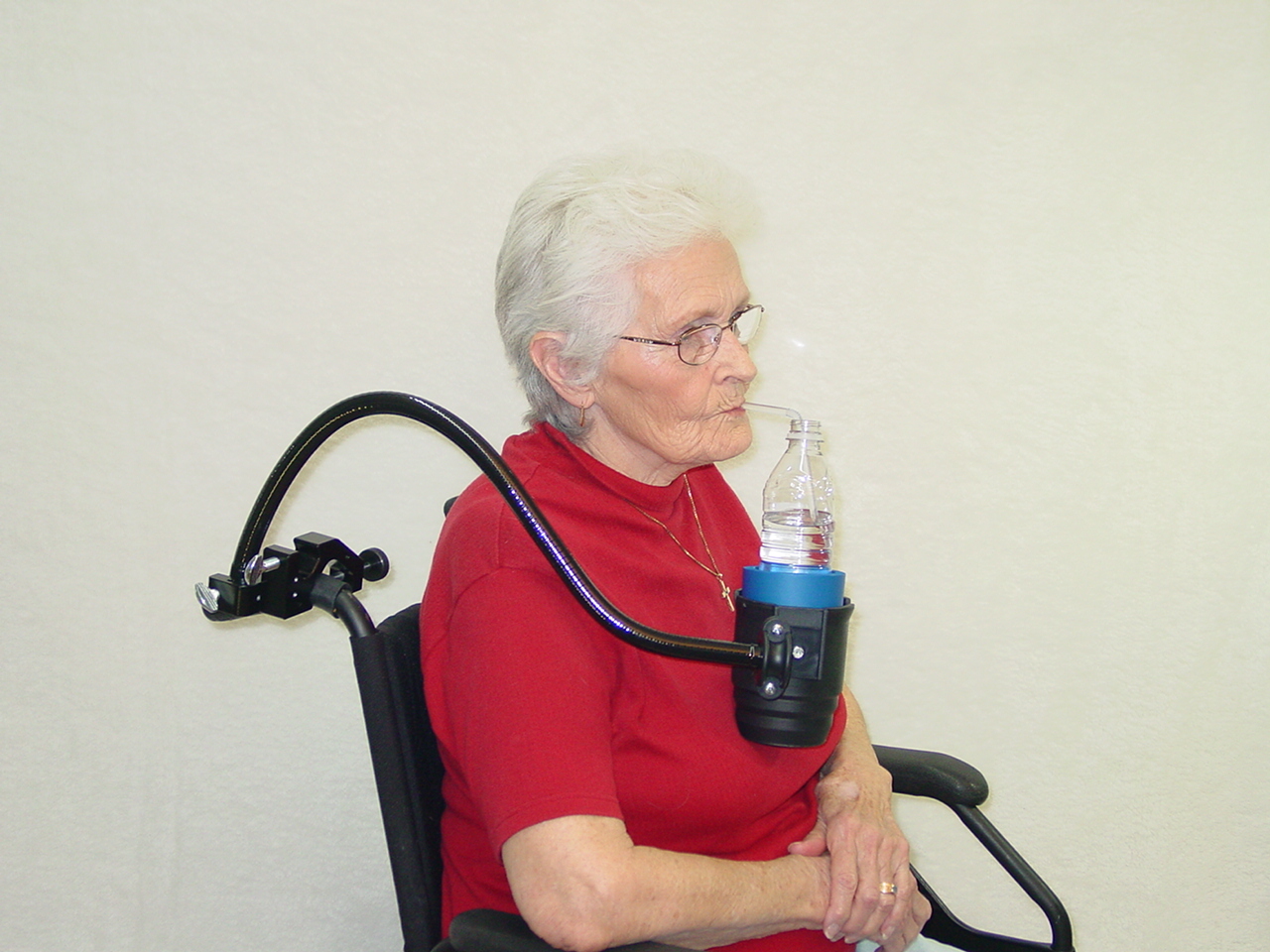 |
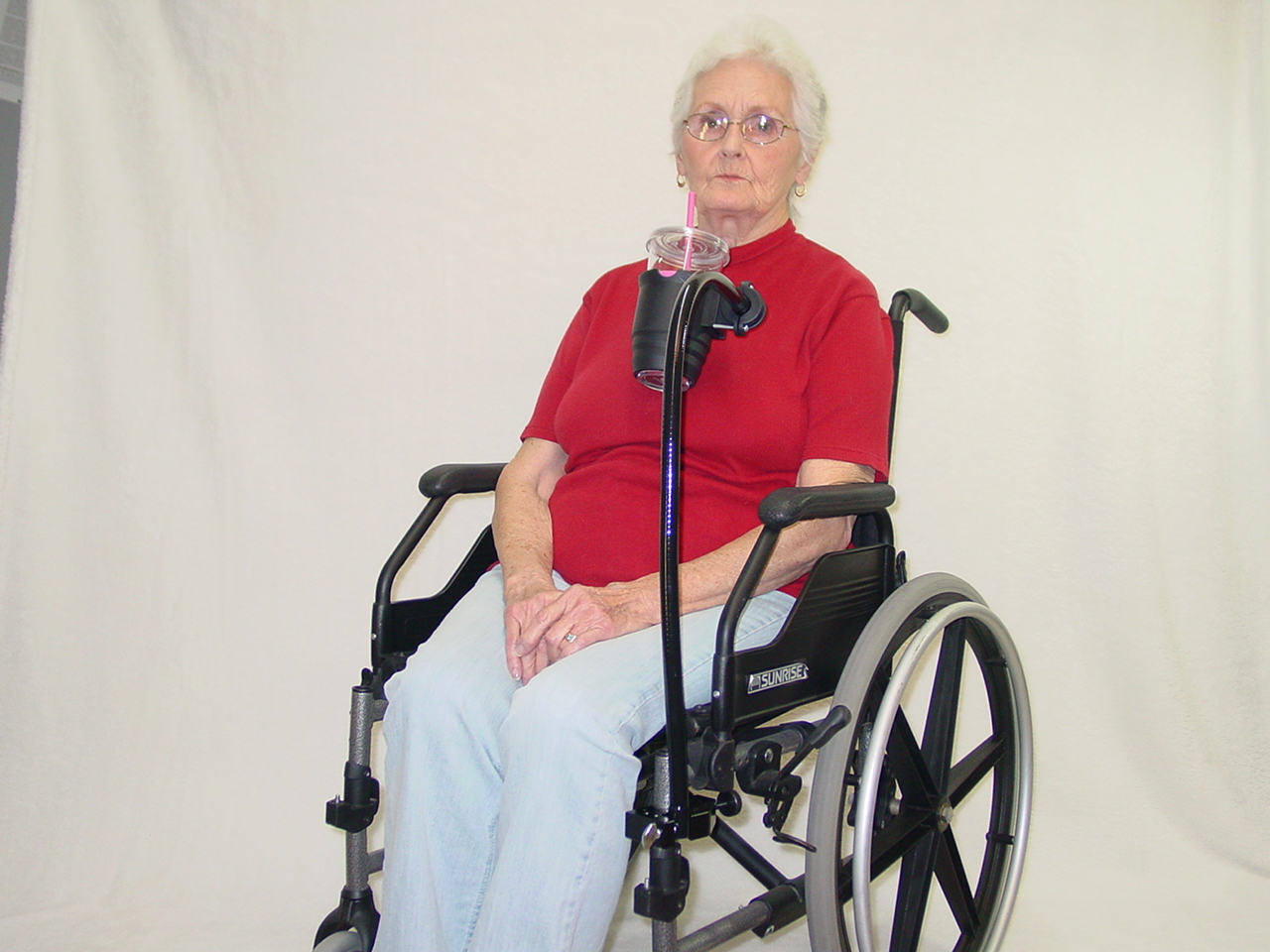 |
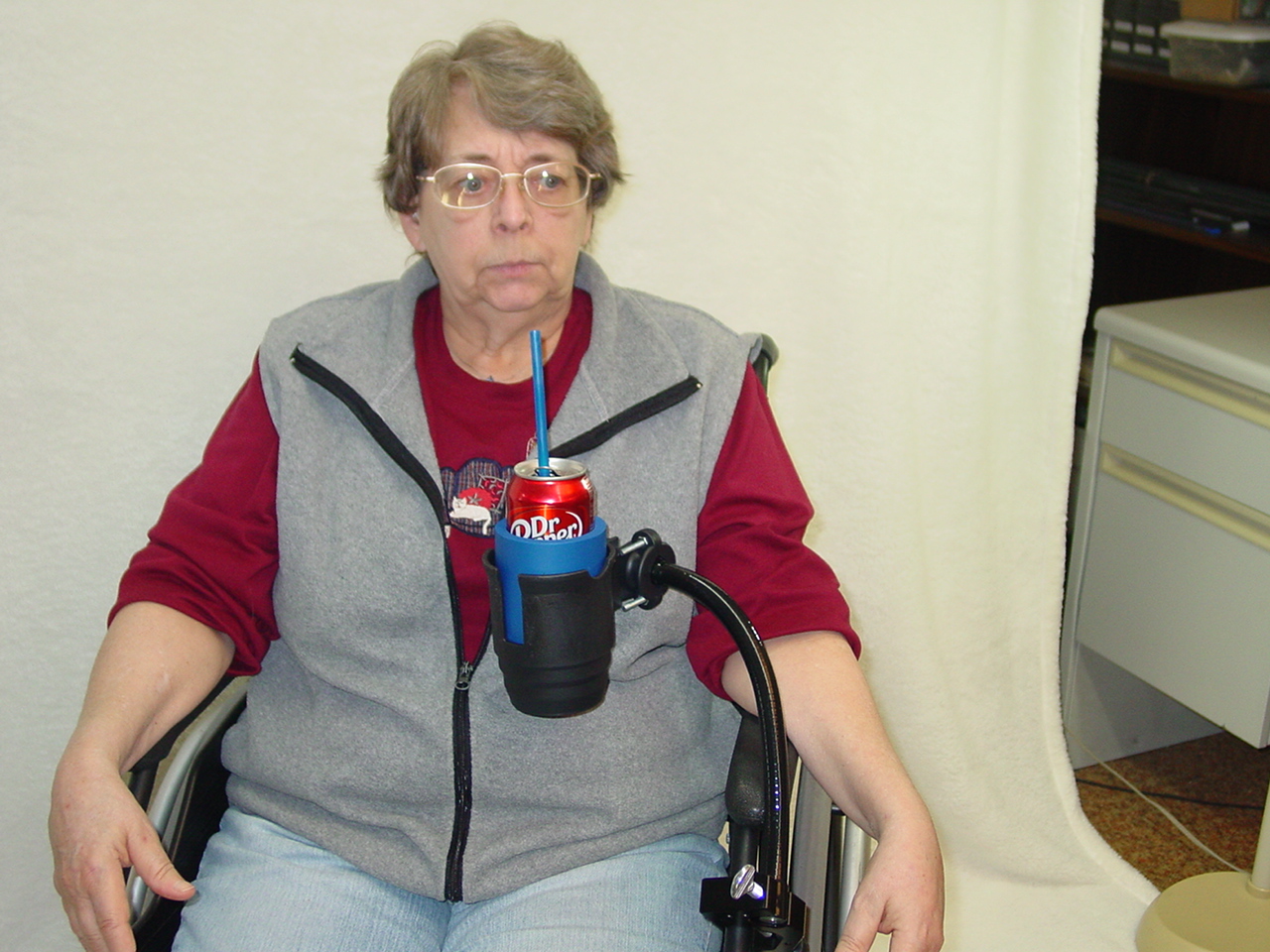 |
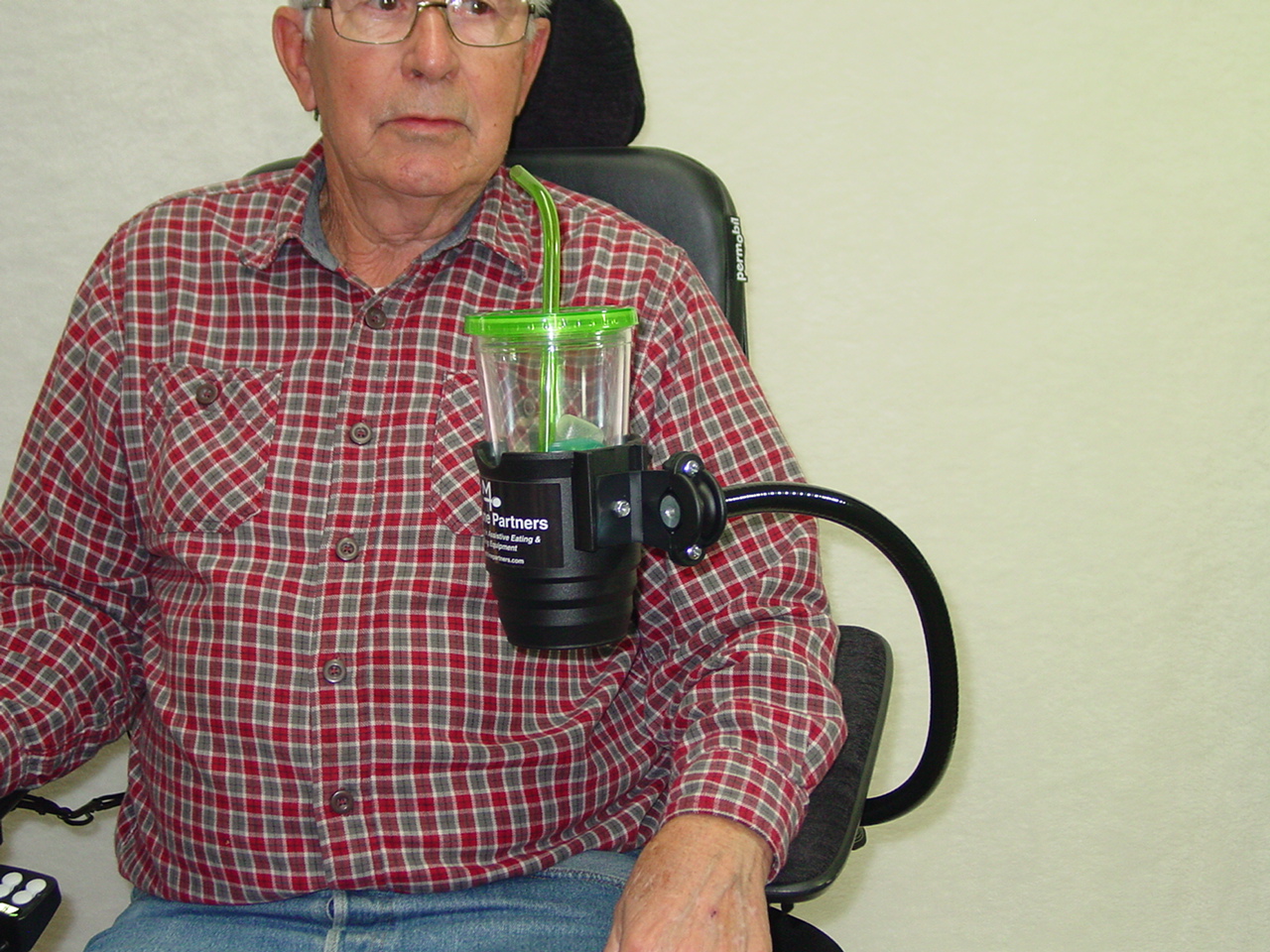 |
Other drinking systems are available that locate the liquid on the back of the wheelchair, which may be preferred because it locates the liquid container out of the way. They can contain more liquid for longer periods of independence, but the user must be able to create more suction to use them.
In conclusion, it is recommended that everyone who needs assistance with drinking, be provided an independent drinking system. Systems that use a straw are simple and safe and with the straw positioned near the user's mouth, permits independent drinking for almost everyone. Just be sure to select a drinking system meeting the user's physical capability for suction and that the straw is compatible with their lip closure/pucker capability to permit sealing the lips around it. For more information about Mealtime Partners Drinking System, including additional considerations for selecting the appropriate drinking system, click here.
| Did You Know? Did you know that spit has evolved rapidly to accommodate the environment in which we live? Researchers at the State University of New York at Buffalo studied the genetic structure of the genes that produce saliva. They found that the thickness and stickiness of saliva is controlled by the MUC7 gene. This gene is responsible for the protein that makes up the spit that moistens our mouth allowing us to chew, swallow, and speak. Also, saliva ensnares the bad bacteria that enter our mouth, thus protecting us. Depending upon what we eat, which depends largely upon where we live, our saliva has evolved to accommodate those needs. It is unusual for any particular species of mammals to have this type of genetic variation, but in the case of saliva it seems to vary in not just humans but also other primates. (Scientific Reports - Recent evolution of the salivary mucinMUC7.) |
September 2016 References:
1. Lowman, D., & Murphy, S., The Educators Guide to Feeding Children with Disabilities. Paul H. Brookes Publishing Co. 1999.
2. Feeding the Disabled Child, Edited by Sullivan, P., and Rosenbloom, L., Mac Keith Press, 1996. (Each chapter authored by different contributors.)
3. Dycem® - manufactured by Dycem Limited in the United Kingdom. This unique material prevents slipping without the need for permanent fixing. Dycem is non-toxic and is easily washed, with a multitude of uses in clinical, home and work settings. Commonly used under plates and glasses, while eating, also great for holding desk top activities in place.
Mealtime Partners Website Navigation:
Home | Dining | Drinking | Videos | All Products | Warranty | Ordering | Calendar | FAQ | Newsletters | Contact
Please send comments and suggestions to newsletters@mealtimepartners.com
Copyright © Mealtime Partners, Inc. 2016
All rights reserved.